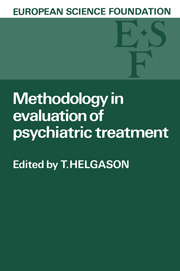 Methodology in Evaluation of Psychiatric Treatment
Methodology in Evaluation of Psychiatric Treatment from III - RATING METHODS IN EVALUATION OF TREATMENT
Introduction
The growing tendency to construct new rating scale systems seems not to be based on intensive analyses of their predecessors. This seems especially to be the case in the field of affective disorders (e.g. Snaith 1981). Thereby the effort to obtain international standards for recording clinical data, for example, in the evaluating of psychiatric treatment, has been delayed. This overview is an attempt to reconsider the use of the prevailing rating scales for affective disorders. In this connection it is important to realize that rating scales are more than operational definitions of clinical data at the level of observation. Rating scales contain, moreover, specific criteria by which the various items of the scale can be combined to syndromes or diagnoses.
In this overview most emphasis will be laid on the rules for combination of items. There are two different elements of such combinations, namely (1) quantitative elements, when measuring the severity of affective states, and (2) qualitative elements when measuring the diagnosis of affective illnesses.
Quantitative rating scales for affective states
General considerations
A symptom rating scale is an instrument for measuring the severity of affective states. Therefore, such scales must contain the most characteristic and observable symptoms for measuring states like depression, anxiety or mania.
Traditionally, the rule for combination of the individual symptoms within quantitative scales is the summed scale score or the total score. However, the resistance shown by clinicians toward the use of rating scales exactly reflects their scepticism about the value of summing different symptoms to a total score. This scepticism is, moreover, shared by statisticians, because the scores obtained by rating scales are categorized values, not truly numerical values. In the statistical inference, therefore, statistical models for categorized data should be used, and only when evidence has been obtained by such analyses can the individual item score be combined to a single total score. The quantitative rating scale which has been the object for most analyses is the Hamilton Depression Scale (Hamilton 1960), and our analysis of this scale will focus on the evidence for using a total score as the rating for depressive states.
To save this book to your Kindle, first ensure [email protected] is added to your Approved Personal Document E-mail List under your Personal Document Settings on the Manage Your Content and Devices page of your Amazon account. Then enter the ‘name’ part of your Kindle email address below. Find out more about saving to your Kindle.
Note you can select to save to either the @free.kindle.com or @kindle.com variations. ‘@free.kindle.com’ emails are free but can only be saved to your device when it is connected to wi-fi. ‘@kindle.com’ emails can be delivered even when you are not connected to wi-fi, but note that service fees apply.
Find out more about the Kindle Personal Document Service.
To save content items to your account, please confirm that you agree to abide by our usage policies. If this is the first time you use this feature, you will be asked to authorise Cambridge Core to connect with your account. Find out more about saving content to Dropbox.
To save content items to your account, please confirm that you agree to abide by our usage policies. If this is the first time you use this feature, you will be asked to authorise Cambridge Core to connect with your account. Find out more about saving content to Google Drive.